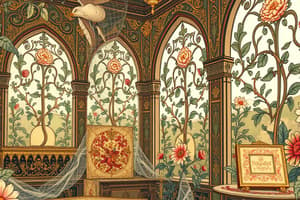Podcast
Questions and Answers
What are the building blocks used by artists to create a work of art called?
What are the building blocks used by artists to create a work of art called?
Elements of Art
What type of line has greater length than width?
What type of line has greater length than width?
Line
Which of the following describes geometric shapes?
Which of the following describes geometric shapes?
- They are free-form shapes.
- They include figures like circle and square. (correct)
- They are only two-dimensional.
- They are natural shapes.
What is defined as the three-dimensional shape that expresses length and width?
What is defined as the three-dimensional shape that expresses length and width?
Negative space refers to the area around and between objects.
Negative space refers to the area around and between objects.
Which of the following is NOT a principle of design?
Which of the following is NOT a principle of design?
Match the following principles of design with their descriptions:
Match the following principles of design with their descriptions:
What is the part of the design that catches the viewer's attention called?
What is the part of the design that catches the viewer's attention called?
Asymmetrical balance refers to elements being similar on both sides.
Asymmetrical balance refers to elements being similar on both sides.
What is the feeling of unity created when all parts relate well with each other?
What is the feeling of unity created when all parts relate well with each other?
Define context in relation to a work of art.
Define context in relation to a work of art.
Formal analysis is a technique used for interpreting visual elements.
Formal analysis is a technique used for interpreting visual elements.
Flashcards
Line
Line
A mark with greater length than width, can be horizontal, vertical, curved, thick, or thin.
Shape
Shape
A closed line which can be geometric (like squares) or organic (natural forms).
Form
Form
Three-dimensional shapes that express length, width, and depth, like a sphere or cube.
Space
Space
Signup and view all the flashcards
Texture
Texture
Signup and view all the flashcards
Color
Color
Signup and view all the flashcards
Balance
Balance
Signup and view all the flashcards
Emphasis
Emphasis
Signup and view all the flashcards
Movement
Movement
Signup and view all the flashcards
Pattern
Pattern
Signup and view all the flashcards
Unity
Unity
Signup and view all the flashcards
Context
Context
Signup and view all the flashcards
Study Notes
Elements of Art
- Line: A mark with greater length than width, can be:
- Horizontal, vertical, or diagonal
- Straight or curved
- Thick or thin
- Shape: A closed line, can be:
- Geometric: Shapes like circles and squares
- Organic: Free-form or natural shapes
- Shapes are flat and express length and width.
- Form: Three-dimensional shapes expressing length, width, and depth (e.g., pyramid, sphere, cube).
- Space: The area between and around objects, can be:
- Negative space: Space around objects
- Positive space: Space within objects
- Space can convey a feeling of depth.
- Texture: The surface quality that can be seen and felt, can be:
- Rough or smooth
- Soft or hard
- Textures may not always feel the way they look.
- Color: The light reflected off an object, with three properties:
- Hue: The name of the color (e.g., red, green, blue)
- Value: How light or dark the color is
- Intensity: How bright or dull the color is
Principles of Design
- Balance: Distribution of visual weight of elements (e.g., objects, colors, textures, space) in a design.
- Symmetrical balance: Elements on one side of the design mirror those on the other.
- Asymmetrical balance: Sides are different but still visually balanced.
- Radial balance: Elements arranged around a central point, often similar.
- Emphasis: The part of the design that captures the viewer's attention, often achieved by contrasting an area with others.
- Movement: The path the viewer's eye takes through the artwork, often to focal areas, directed by lines, edges, shapes, colors.
- Pattern: Repetition of an object or symbol throughout the artwork.
- Repetition: Works with pattern to create visual activity and unity in the artwork.
- Proportion: Feeling of unity created by harmonious relationships between sizes, amounts, or numbers of elements.
- Rhythm: Created by repeating elements of design to create a feeling of organized movement, like music or dancing.
- Variety: Use of diverse elements of design to hold the viewer's attention and guide their eye.
- Unity: Feeling of harmony between all parts of the artwork, creating a sense of wholeness.
Context and Themes
- Context encompasses the factors surrounding a work of art.
- Inquires about context:
- Historical events during the artwork's creation
- Scientific discoveries or technological innovations that may have influenced the artist
- Other artistic influences on the work
- Philosophical ideas of the time informing the artwork
- Cultural influences
- Intended audience
- Artist's association with a particular movement, school, or style
- Original purpose of the artwork
- Classifications of art context:
- Formal Analysis: A technique for organizing visual information, focusing on describing what you see in the artwork.
- Description: Detailing the visual elements of the artwork, including lines, colors, textures, space, and composition.
Studying That Suits You
Use AI to generate personalized quizzes and flashcards to suit your learning preferences.



